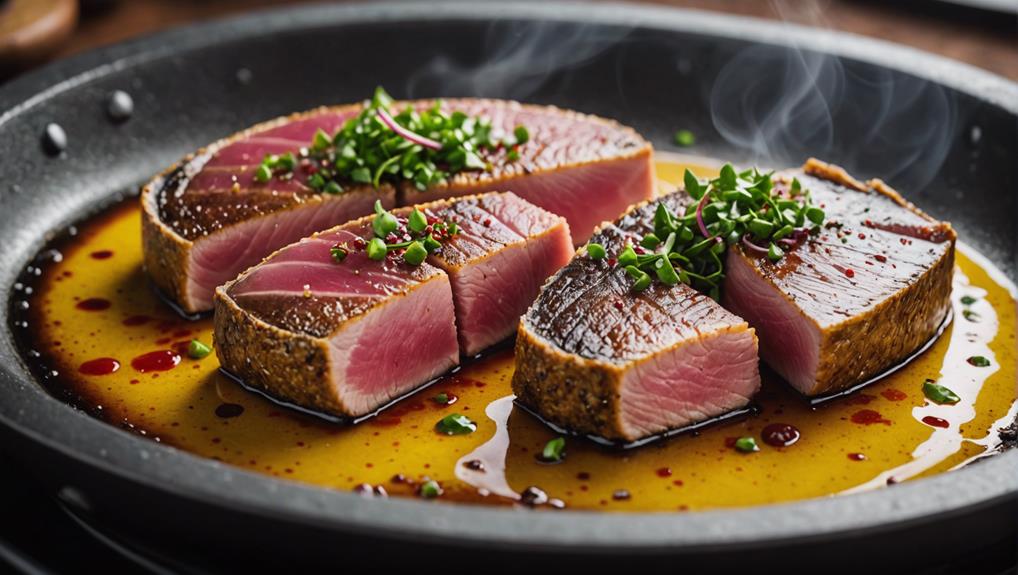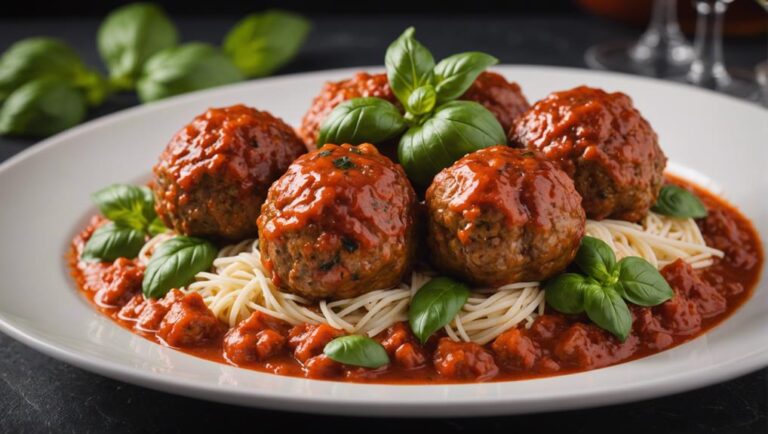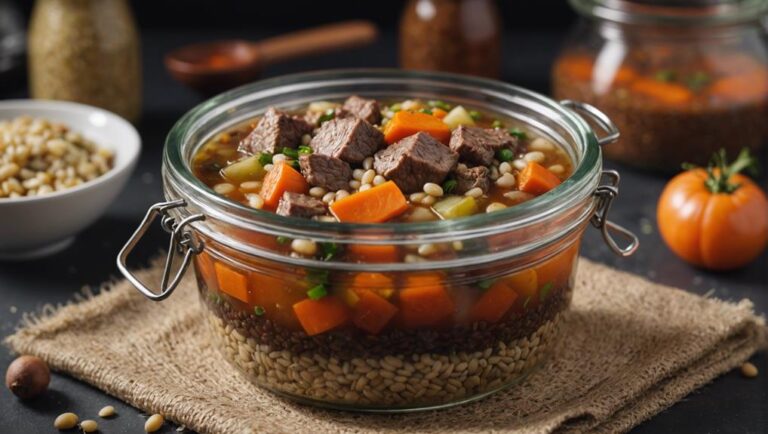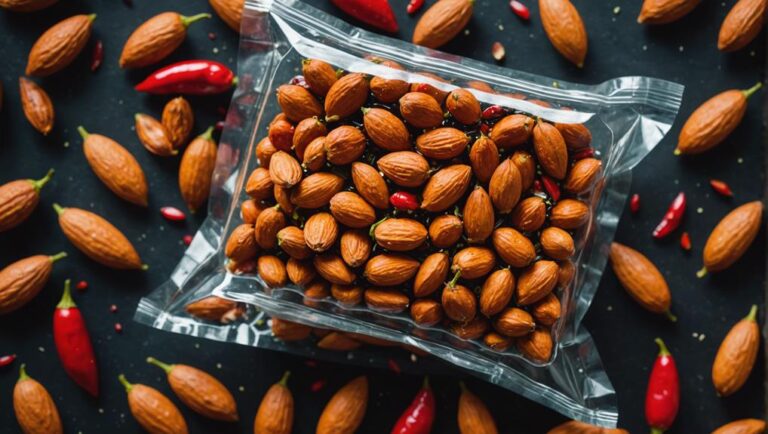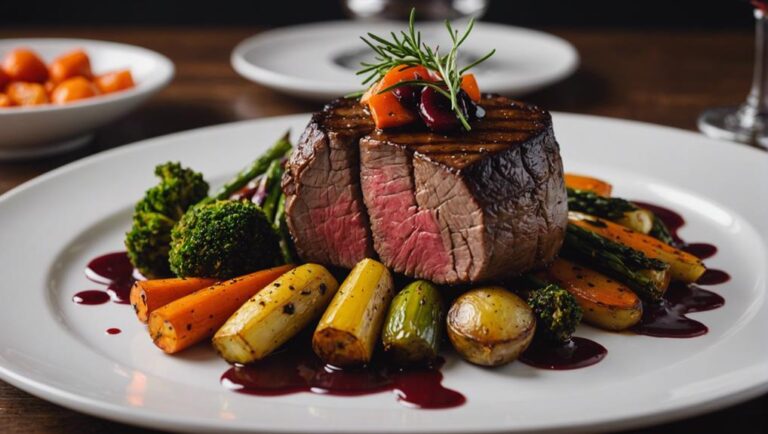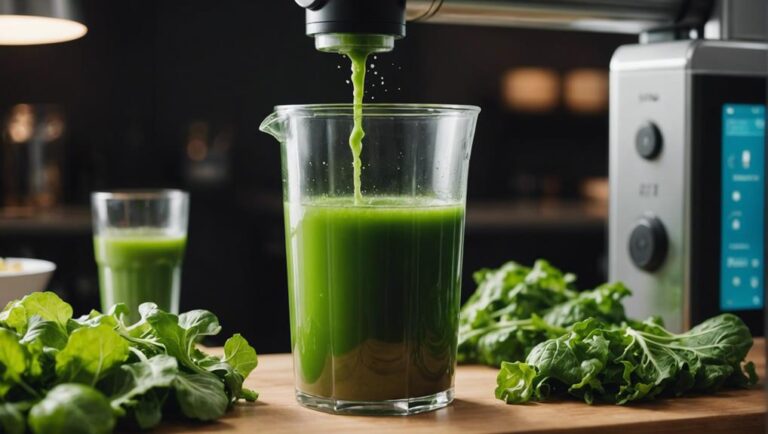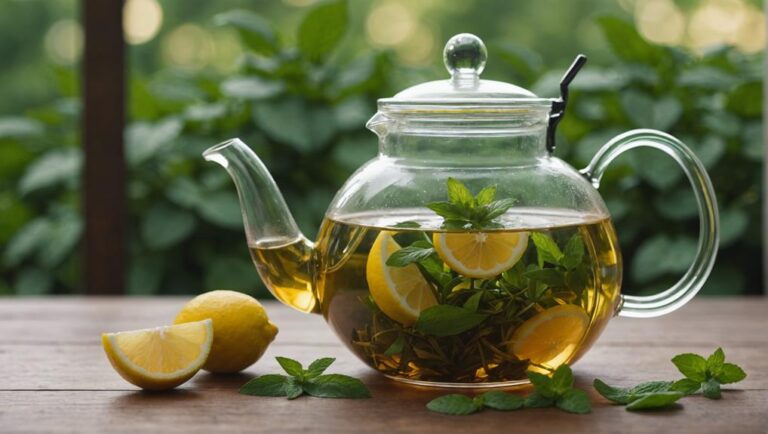Sous Vide Pepper-Crusted Tuna Steaks
When making sous vide pepper-crusted tuna steaks, seal the tuna with peppercorns and seasonings in a bag. Cook in a water bath for tenderness. Finish by searing the tuna in a hot skillet to get a crispy, caramelized crust. The sous vide method guarantees the tuna remains moist and flavorful throughout. The pepper crust adds a zesty kick to each bite. Mastering this technique is a game-changer for your tuna dishes, creating a restaurant-quality experience in your own kitchen. Discover the secrets to perfectly cooked and seasoned tuna with this innovative cooking approach.
What You Will Learn Here
- Sous vide ensures precise doneness and tenderness.
- Pepper crust adds a flavorful and crunchy outer layer.
- Retains moisture and natural juices for succulent tuna.
- Enhances tuna's delicate texture and flavor profile.
- Searing after sous vide creates a perfect contrast in textures.
Tuna's Evolutionary Background
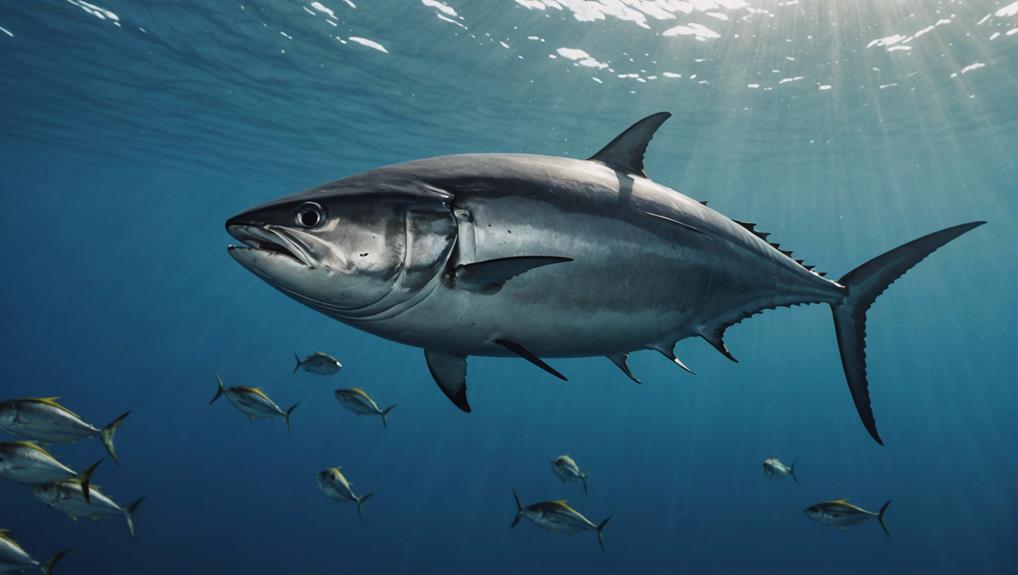
Tuna species have evolved diverse characteristics over time to adapt to their environments. Their streamlined bodies enable them to swiftly navigate the open ocean, outmaneuvering predators and covering vast distances in search of prey.
As carnivorous predators, tuna play an essential role in the marine food chain, preying on smaller fish, squid, and crustaceans to sustain their energy needs.
Tuna Species Diversity
Part of the mackerel family, tuna species exhibit a diverse range of characteristics, each uniquely adapted for survival in different marine environments. Bluefin tuna stand out as some of the largest and most sought-after species, with individuals exceeding 1,000 pounds in weight.
Yellowfin tuna, distinguished by their yellow fins and tail, are particularly valued in commercial fisheries and sushi markets. Albacore, bigeye, and skipjack tuna also contribute to the species diversity, each with its own distinct traits. These powerful swimmers possess streamlined bodies that enable swift movements through the water, essential for capturing prey.
Their retractable fins and specialized blood-warming system further enhance their efficiency, especially in cold oceanic environments where they're commonly found.
Adaptations for Survival
Emerging from the depths of the ocean's vast expanse, the evolutionary background of tuna reveals a story of remarkable adaptations for survival that have enabled these swift and powerful marine predators to thrive in diverse aquatic ecosystems.
Tuna's evolved streamlined bodies grant them speed and agility, vital for hunting and evading predators in the open ocean. Their efficient respiratory system supports their high metabolic rate, allowing them to sustain prolonged swims across vast distances.
Keen senses, including sharp vision and a strong sense of smell, aid in locating prey in the expansive marine environment. With the ability to regulate body temperature and endure varying conditions, tuna have become resilient migratory fish, capable of withstanding the challenges of ocean life.
These adaptations have secured their successful evolution as top-tier marine predators.
Predators and Prey
Darting through the vast expanse of the ocean, these swift predators with streamlined bodies exemplify evolutionary mastery in the domain of hunting and survival. Tunas, with their torpedo-shaped physiques and powerful muscles, are designed to chase down prey efficiently and evade predators in the marine ecosystem.
Their circulatory system, highly evolved to regulate body temperature and oxygen levels even in cold, deep waters, gives them an edge in the hunt. Opportunistic feeders, tunas prey on a variety of fish, squid, and crustaceans, showcasing their adaptability and prowess.
Through evolutionary adaptations like a unique muscle and fin arrangement, these apex predators have carved a niche as formidable hunters in the vast underwater world.
Tuna Varieties for Sous Vide
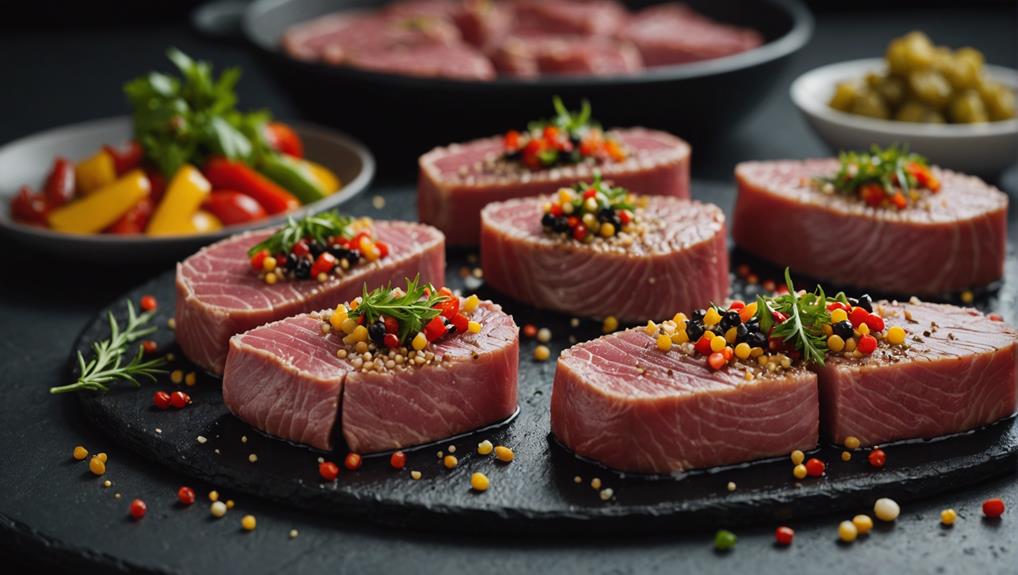
When exploring tuna varieties for sous vide cooking, yellowfin and bluefin tuna stand out for their firm texture and rich flavor profile. Yellowfin tuna, known for its slightly pink flesh and meaty texture, holds up well to sous vide cooking, resulting in a moist and flavorful dish. Bluefin tuna, with its deep red color and buttery texture, offers a luxurious dining experience when prepared using sous vide techniques.
Skipjack tuna, although not as fatty as bluefin, is a popular choice for its mild flavor and versatility in various dishes.
Albacore tuna, with its tender texture and delicate flavor, is a great option for those seeking a lighter and more subtle tuna taste.
Bigeye tuna, prized for its buttery texture and deep flavor, is a premium choice for a gourmet sous vide experience.
Tuna varieties like bonito and skipjack, commonly used in Japanese cuisine, can be elevated through sous vide methods for a modern twist on traditional dishes.
Tasty Tuna Sous Vide Options
When exploring tasty tuna sous vide options, you can savor the succulence of Seared Tuna with Herbs, which pairs beautifully with a zesty citrus-soy glaze.
Alternatively, indulge in the freshness of Tuna Tartare with Avocado Dice, a dish that harmonizes the delicate flavors of tuna and creamy avocado.
These options showcase the versatility of sous vide cooking in elevating tuna dishes to new levels of taste and texture.
Seared Tuna With Herbs
Enhancing the succulent flavors of sous vide tuna, incorporating a medley of aromatic herbs like thyme, dill, and citrus zest brings a fresh and nuanced dimension to your seared tuna experience. When searing Ahi tuna after sous vide cooking, the pepper crust adds a crispy and flavorful exterior, providing a bold and aromatic coating. The herbs infuse the tuna with subtle and fresh notes, perfectly complementing the pepper crust. This method guarantees a restaurant-quality dish with sous vide precision-cooked interior, elevating your culinary skills to new heights.
- Herb Infusion: Thyme, dill, and citrus zest bring a fresh and nuanced flavor profile.
- Crispy Texture: Pepper crust adds a crispy and flavorful exterior to the tuna.
- Aromatic Coating: The herbs and pepper crust combine to provide a bold and aromatic coating.
- Restaurant-Quality: Achieve a high-quality seared tuna dish with sous vide precision.
Citrus-Soy Glaze Recipe
To further enhance the exquisite flavors of your sous vide pepper-crusted tuna steaks, consider adding a zesty Citrus-Soy Glaze that infuses a burst of citrusy freshness and savory sweetness to your dish.
The Citrus-Soy Glaze recipe includes soy sauce, orange juice, lime juice, honey, garlic, and ginger, creating a flavorful finishing touch. Simmering these ingredients together results in a zesty, sweet, and savory glaze that elevates the taste of the cooked tuna steak.
Drizzle this glaze over the tuna steak to enhance its flavor profile and add a burst of citrusy freshness. The harmonious blend of flavors between the pepper-crusted tuna steaks and the Citrus-Soy Glaze offers a simple yet impactful way to add depth and complexity to your sous vide dish.
Tuna Tartare With Avocado Dice
For a delectable twist on traditional tuna dishes, elevate your culinary experience with Tuna Tartare featuring succulent avocado dice alongside sous vide-cooked tuna. When preparing this dish, opting for high-quality tuna steaks guarantees a premium taste and texture.
Avocado dice adds a creamy and buttery contrast to the tuna, creating a delightful harmony of flavors. The precision cooking of sous vide maintains the freshness of the tuna, resulting in a dish bursting with vibrant flavors. Seasoning the tuna with a pepper crust not only enhances its taste but also adds a visually appealing element to the presentation.
This combination of ingredients offers a unique texture and flavor combination that will surely impress your taste buds.
Sous Vide Tuna Searing Technique
When searing your sous vide tuna steak, make sure the skillet is preheated to a high temperature for a quick sear. Aiming for a temperature around 450°F will help achieve that perfect caramelized crust.
Remember to sear each side of the tuna steak quickly to maintain its tender texture and enhance the overall flavor profile.
Searing Temperature Recommendation
Utilizing a searing temperature of approximately 450°F when finishing sous vide tuna steaks results in a delectably caramelized exterior that perfectly complements the rare interior. This high searing temperature is essential for developing a flavorful crust on the tuna while maintaining its desired rareness. Achieving a quick sear at 450°F guarantees that the exterior of the tuna steak caramelizes beautifully without overcooking the inside. The pepper-crusted tuna steaks benefit greatly from this high searing temperature, enhancing both their appearance and taste. The table below summarizes the importance of searing tuna steaks at 450°F.
| Searing Temperature | Benefits |
|---|---|
| 450°F | Delectably caramelized exterior |
| Complements rare interior | |
| Enhances appearance and flavor | |
| Quick sear without overcooking the tuna | |
| Ideal for pepper-crusted tuna steaks |
Searing Duration Tips
To guarantee your sous vide tuna steaks achieve the perfect sear, focus on mastering the ideal duration for searing. After cooking sous vide, aim for 1-2 minutes per side when searing your tuna steaks.
Utilize a hot cast iron skillet for an efficient and even sear, ensuring a flavorful crust while preserving the tender interior of the fish. The high heat from searing plays a significant role in caramelizing the pepper crust, enhancing both the taste and texture of the seared tuna.
Not only does proper searing impact the flavor profile, but it also boosts the visual appeal of your dish, creating an appetizing presentation that will impress your guests.
Searing Surface Options
For achieving the perfect sear on your sous vide tuna steaks, consider the various options available for your searing surface, such as a cast iron skillet, grill, or a heavy pan.
Each option provides a unique way to sear the tuna steak, impacting its final texture and flavor. A cast iron skillet offers even heat distribution, creating a uniform caramelized crust on the exterior of the tuna.
On the other hand, grilling imparts a smoky flavor and distinctive grill marks. A heavy pan can also achieve a beautifully seared tuna steak.
The searing process not only enhances the taste but also creates a delightful contrast between the tender interior and crispy exterior of the tuna steak, elevating the overall dining experience.
Final Thoughts
In conclusion, the harmony of flavors and textures achieved through sous vide cooking and the pepper crust technique elevates these tuna steaks to a gourmet dining experience. By utilizing a sous vide cooker, you guarantee that the tuna is cooked perfectly to your desired level of doneness.
The salt and pepper in the crust enhance the natural flavors of the tuna, while a quick sear in a hot skillet creates a crispy exterior that contrasts beautifully with the tender, moist interior. Before searing, patting the tuna dry with a paper towel ensures a good sear and avoids steaming the fish.
Adding aromatic herbs and spices to the olive oil for searing infuses the tuna with additional layers of flavor. The final touch of a citrus-soy glaze not only adds a burst of tangy sweetness but also ties all the elements together for a truly memorable dining experience.
Frequently Asked Questions
How Long Do You Sous Vide Tuna Steaks?
When sous vide cooking tuna steaks, you should consider the steak's thickness. For one-inch steaks, cook for 30-45 minutes, and thicker cuts may need 45 minutes to an hour. Tailor the time for the desired texture.
What Is the Best Temp for Tuna Steaks?
For the best temp of tuna steaks, aim for 105°F for sashimi-like or 130°F for canned tuna-like texture in sous vide cooking. Adjusting the temp impacts texture and doneness. Experiment to find your perfect balance.
Why Do You Not Cook Tuna Steaks All the Way?
You don't cook tuna steaks all the way to preserve their tenderness and flavor. Keeping them rare or medium-rare prevents dryness. Searing the outside while maintaining a pink or red center creates a juicy and delicious contrast in texture.
How Do You Cook Tuna Steaks Without Drying Them Out?
To cook tuna steaks without drying them out, seal them in a bag for sous vide cooking. This method retains moisture and flavors. By cooking at precise temperatures, you achieve perfectly moist tuna. Sear quickly after for a flavorful crust.
Conclusion
To sum up, sous vide pepper-crusted tuna steaks offer a delicious and precise way to achieve the perfect sear while maintaining the fish's delicate texture and flavor.
By choosing the right tuna variety and utilizing the proper sous vide techniques, you can create a mouthwatering dish that's sure to impress.
Experiment with different seasonings and cooking times to find your preferred flavor profile, and enjoy a restaurant-quality meal in the comfort of your own home.
